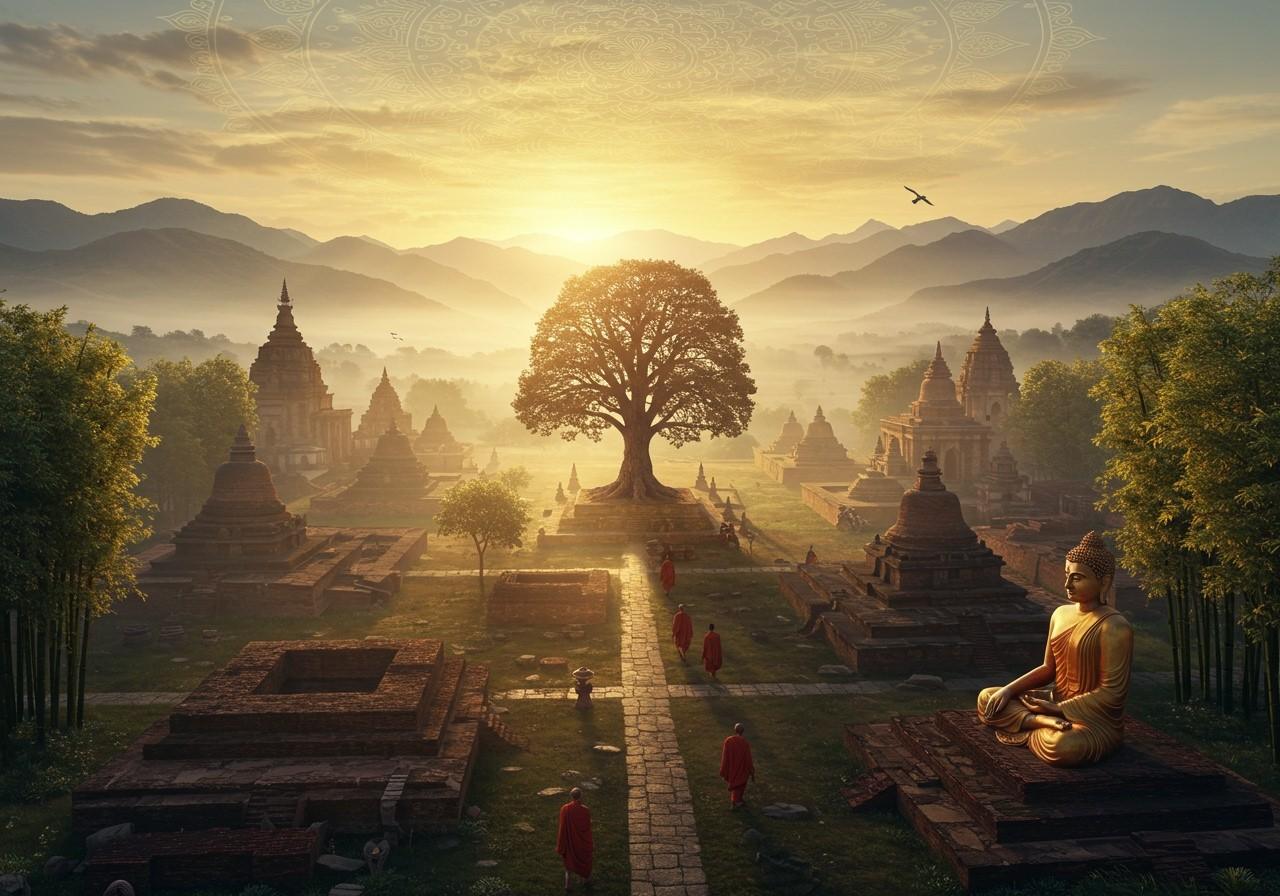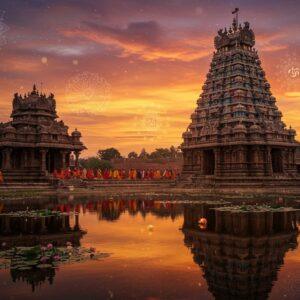
Rajgir, formerly known as Rajagriha, stands as a city steeped in history and spirituality, particularly for followers of Buddhism. Situated in Bihar, India, it served as an early capital of the Magadha kingdom and played a pivotal role in the life of Siddhartha Gautama, the Buddha. It also became a central hub for Buddhist teachings and councils. This ancient city, nestled in the Nalanda district, boasts a rich heritage, having served as a prominent center for various dynasties, including the Mauryan Empire. Its religious significance extends to both Buddhism and Jainism, as historical figures like Buddha and Mahavira graced its grounds with their presence.
Historical Significance of Rajgir in Buddhism
Rajgir occupies a special place in Buddhist history due to its close association with the Buddha. The city is where the Buddha spent several rainy seasons meditating and teaching in Rajgir, thus solidifying its importance in his early teachings. Rajgir is also renowned as the site of the First Buddhist Council, held within the Saptparni caves following Buddha’s passing. This pivotal event ensured the preservation and compilation of his profound teachings, shaping the future of Buddhism.
Key Buddhist sites in Rajgir include:
- Vulture Peak (Griddhakuta Hill): This iconic hilltop served as the location for numerous important sermons delivered by the Buddha, attracting disciples and followers eager to hear his wisdom. The panoramic views and serene atmosphere made it an ideal setting for spiritual contemplation and discourse.
- Monasteries and Caves: Rajgir’s landscape is dotted with ancient monasteries and caves, showcasing the city’s significance as a monastic center during the Buddha’s time. These sacred spaces provided shelter and sanctuary for monks dedicated to practicing and spreading the Buddha’s teachings.
- Historical Accounts: Chinese pilgrims, such as Xuanzang (7th century CE) and Faxian (circa 400 CE), meticulously documented Rajgir’s importance in their travelogues. These detailed accounts provide valuable insights into the city’s flourishing Buddhist community and its sacred sites.
- Archeological Findings: Archaeological excavations in Rajgir have unearthed inscriptions and relics that further substantiate the city’s profound connection with Buddhism. These discoveries offer tangible evidence of the city’s rich past and its role in the development of Buddhism.
Rajgir’s Role in the Life of the Buddha
Rajgir was a pivotal location in the Buddha’s journey toward enlightenment and his subsequent teachings. After attaining enlightenment, the Buddha dedicated considerable time in Rajgir disseminating his newfound wisdom. King Bimbisara, the ruler of Magadha, embraced the Buddha’s teachings and became a devoted follower, demonstrating the city’s royal patronage of Buddhism.
Important figures and sites related to the Buddha in Rajgir include:
- King Bimbisara: A key patron of the Buddha, King Bimbisara established the Venuvana monastery to provide the Buddha and his disciples with a dedicated space for their spiritual practices. This act of generosity solidified Rajgir’s status as a center for Buddhist learning and community.
- Saptaparni Cave: This cave holds immense historical significance as the venue for the First Buddhist Council. It was here that the Buddha’s teachings (Dhamma) and monastic rules (Vinaya) were compiled and preserved for future generations.
- Vulture Peak Sermons: The Buddha delivered many profound sermons on Vulture Peak, including the revered Heart Sutra, a concise yet powerful text that encapsulates the essence of Mahayana Buddhist philosophy.
- Natural Formations: Rajgir’s natural landscape, with its surrounding hills and serene environment, provided ideal settings for meditation and spiritual practice. The tranquility of the area contributed to the development of a vibrant Buddhist community.
The First Buddhist Council and Its Impact
The First Buddhist Council, convened in Rajgir shortly after the Buddha’s death (circa 483 BCE), was a landmark event in Buddhist history. Its primary objective was to preserve the Buddha’s teachings and establish monastic regulations. Five hundred senior monks, led by Maha Kassapa, participated in this crucial gathering.
Key aspects of the council include:
- Oral Recitation: The council involved the meticulous oral recitation and compilation of the Buddha’s teachings (Dhamma) and the monastic code of conduct (Vinaya). This ensured the accurate transmission of the Buddha’s words and the establishment of a unified monastic tradition.
- Ananda’s Role: Ananda, the Buddha’s devoted attendant, played a vital role in reciting the Sutta Pitaka, the collection of the Buddha’s discourses. His exceptional memory and close proximity to the Buddha made him a crucial source for preserving the teachings.
Connecting with Buddhist Heritage through Poojn.in
Poojn.in, India’s leading online store for spiritual and religious products, offers a wide range of authentic Buddhist items to help individuals connect with their heritage. We provide:
- Exquisite Buddha Statues: Discover beautifully crafted Lord Buddha statues made from high-quality materials such as marble dust, perfect for creating a serene atmosphere in your home or meditation space. These statues serve as a focal point for reverence and contemplation.
- Pooja Samagri: We offer a comprehensive selection of pooja samagri and ritual items essential for Buddhist ceremonies and practices. From incense and offering bowls to prayer beads and meditation cushions, we provide everything you need to create a sacred space.
Our featured product, the Hand-Crafted Lord Buddha Marble Dust Idol (15 cm), embodies the serenity and spiritual essence of Rajgir’s Buddhist heritage. This meticulously crafted statue adds a touch of sacred beauty to any space.
For personalized assistance with Buddhist ritual items or any spiritual needs, contact our knowledgeable team at 91 7908548235. We deliver across India, bringing authentic Buddhist items directly to your doorstep.
Visit our website at www.poojn.in to explore our complete collection.
Conclusion
Rajgir remains a powerful testament to the enduring spiritual and historical legacy of Buddhism. Its serene landscapes and sacred sites continue to draw pilgrims and seekers from around the globe. By exploring Rajgir, we connect with the Buddha’s profound teachings and the heritage of his early followers.
FAQs on Rajgir and Buddhism
What is Rajgir’s significance in Buddhism? Rajgir holds immense significance as a major city during the Buddha’s time, where he resided for extended periods and delivered numerous important teachings, shaping the core principles of Buddhism.
Where is Rajgir located? Rajgir is located in Bihar, India, nestled amidst picturesque hills, adding to its spiritual aura.
What happened at the First Buddhist Council in Rajgir? The First Buddhist Council, held shortly after the Buddha’s passing, was convened to preserve his teachings and monastic discipline, resulting in the compilation of the Tripitaka, the foundational Buddhist scriptures.
Why is Rajgir important for Buddhist pilgrims? Rajgir serves as a significant pilgrimage destination due to its numerous ancient monasteries, caves, and sites where the Buddha meditated and taught, offering pilgrims a profound connection to his life and teachings.
Can visitors explore ancient sites in Rajgir? Yes, visitors can explore a wealth of ancient sites, including Vulture Peak, Saptaparni Cave, and the ruins of ancient monasteries, providing a glimpse into the rich history of Buddhism in the region.


